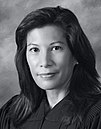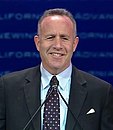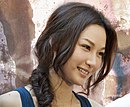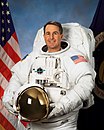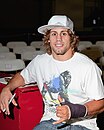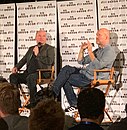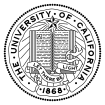University of California, Davis
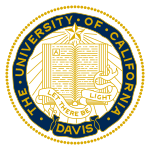 | |
Former names | University Farm (1905–1922) Northern Branch of the College of Agriculture (1922–1938) College of Agriculture at Davis (1938–1959) |
|---|---|
| Motto | Fiat lux (Latin) |
Motto in English | "Let there be light" |
| Type | Public land-grant research university |
| Established | March 18, 1905[1] (1959 as a general UC campus) |
Parent institution | University of California |
| Accreditation | WSCUC |
Academic affiliations | |
| Endowment | $678 million (FY2023) (UC Davis only)[2][3] $1.5 billion (FY2023) (Regents portion)[3][a] |
| Budget | $7.1 billion (FY2024)[4] |
| Chancellor | Gary S. May[5] |
| Provost | Mary Croughan[6] |
Academic staff | 2,175 (fall 2023)[7] |
| Students | 40,848 (fall 2023)[8] |
| Undergraduates | 31,797 (fall 2023)[7] |
| Postgraduates | 7,912 (fall 2023)[7] |
| Location | , , United States 38°32′24″N 121°45′0″W / 38.54000°N 121.75000°W |
| Campus | Small suburb[10], 7,331 acres (2,967 ha)[9] |
| Other campuses | |
| Newspaper | The California Aggie |
| Colors | Aggie blue and gold[11] |
| Nickname | Aggies |
Sporting affiliations | |
| Mascot | Gunrock the Mustang |
| Website | ucdavis |
| ASN | 6192 |
The University of California, Davis (UC Davis, UCD, or Davis) is a public land-grant research university in Davis, California, United States.[12] It is the northernmost of the ten campuses of the University of California system. The institution was first founded as an agricultural branch of the system in 1905 and became the sixth campus of the University of California in 1959.
Founded as a primarily agricultural campus, the university has expanded over the past century to include graduate and professional programs in medicine (which includes the UC Davis Medical Center), engineering, science, law, veterinary medicine, education, nursing, and business management, in addition to 90 research programs offered by UC Davis Graduate Studies. The UC Davis School of Veterinary Medicine is the largest veterinary school in the United States. UC Davis also offers certificates and courses, including online classes, for adults and non-traditional learners through its Division of Continuing and Professional Education.[13]
The university is considered a Public Ivy.[14] It is classified among "R1: Doctoral Universities – Very high research activity".[15] The UC Davis Aggies athletic teams compete in NCAA Division I, primarily as members of the Big West Conference with additional sports in the Big Sky Conference (football only) and the Mountain Pacific Sports Federation. Athletes from UC Davis have won a total of 10 Olympic medals. University faculty, alumni, and researchers have been the recipients of two Nobel Prizes, one Fields Medal, a Presidential Medal of Freedom, three Pulitzer Prizes, three MacArthur Fellowships, and a National Medal of Science.[16][17][18][19][20] Of the current faculty, 30 have been elected to the National Academy of Sciences, 36 to the American Academy of Arts and Sciences, and 13 to the National Academy of Medicine.[21][22][23]
History
[edit]Agriculture and the land-grant university
[edit]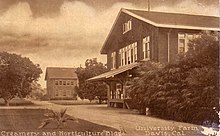
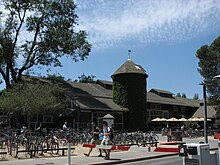
In 1868, the University of California was established as a land-grant university, and immediately founded a College of Agriculture as its first college as required by the Morrill Land-Grant Acts and the university's own Organic Act.[24][25] UC operated a small farm at the Berkeley campus for several years after Ezra S. Carr became professor of agriculture, but he managed to alienate both the university faculty and the state's farmers with his attempt to directly integrate practical training in farming with courses on the larger historical, social, and political dimensions of farming and got himself fired in 1874.[26]
Eugene W. Hilgard, Carr's successor, recognized that Berkeley's soil and climate were terrible for farming (the campus directly faces the notoriously foggy Golden Gate) and switched from "practical" to what he called "rational" instruction in scientific principles of agriculture at Berkeley.[27] He concentrated on soil science and fermentation that could be researched and taught in a university laboratory, supplemented by limited data gathering and experiments (but not hands-on teaching) at agricultural experimental stations in the field.[28] Hilgard was disdainful of the idea of a university farm.[29]
Founding of the university farm
[edit]Around the turn of the 20th century, Peter J. Shields, secretary of the California Agricultural Society, became aware that colleges of agriculture elsewhere had university farms which performed experiments and provided hands-on education in useful agricultural subjects, and that young people were leaving the state to study at such farms.[30] Shields began to champion the cause of a university farm. He was later honored as the "founder" of UC Davis in 1962, when the Shields Oak Grove on campus was named after him, and again posthumously in 1972 when the campus library was named after him.[31] However, local farmer and politician George Washington Pierce Jr. also fought aggressively in the California State Assembly for the creation of a university farm.[31] Shields himself credited Pierce with ensuring that the site criteria in the University Farm Bill were so tightly formulated that they could be met only at the Yolo County town of Davisville.[31] Unlike Shields, Pierce did not live long enough to see the promotion of Davis to a general campus and is now largely forgotten.[31]
On March 18, 1905, the University Farm Bill was enacted, which called for the establishment of a farm for the University of California.[32][33] The bill provided that the University Farm would "be typical and representative of the best general agricultural conditions in California", and authorized an appropriation of $150,000 to cover the cost of purchasing land and constructing appropriate buildings.[33] A committee appointed by the Regents of the University of California took a year to select a site for the University Farm, a 779-acre portion of the stock farm of Jerome C. Davis, near a tiny town then known as Davisville.[32][34] The regents officially took control of the property in September 1906 and constructed four buildings in 1907.
Short courses were first offered in October and November 1908, and then the University Farm officially opened in 1909 as the University Farm School, offering a three-year non-degree vocational program.[34] The vocational program was shortened from three to two years in 1923.[35]
From vocational certificates to bachelor's degrees
[edit]In 1916, the Farm's 314 students occupied the original 778 acres (315 ha) campus. The institution grew at a breakneck pace over the next four decades. By 1951, it had expanded to a size of 3,000 acres (1,200 ha).[36] Along the way, it was renamed in 1922 to become the Northern Branch of the College of Agriculture, and in 1938, it became the College of Agriculture at Davis.
Initially, no degrees were awarded at Davis.[37] Students in the College of Agriculture at Berkeley often enrolled at Davis for a single semester to obtain practical training on an actual farm alongside the vocational students, but had to return to Berkeley to earn their degrees.[32][37] Because the non-degree vocational program at Davis was so disconnected from the traditional degree programs on the main Berkeley campus, agricultural interests began to agitate to separate Davis and the entire College of Agriculture from the University of California.[37] This forced the regents in 1922 to silence such proposals by initially authorizing a two-year undergraduate program at Davis.[37] By sharing faculty members between Berkeley and Davis and hiring a few more faculty members, the university was able to provide almost all courses of a "complete undergraduate program" at Davis—that is, a four-year program leading to the bachelor's degree.[37] The first class graduated from Davis in 1926.[35]
UC regularly appointed faculty members to joint positions at both Berkeley and Davis.[38] This was possible because the two campuses are separated by only 53 miles (85 km), and the opening of a new bridge over the Carquinez Strait in 1927 greatly shortened the drive between them. Sharing faculty meant that the two campuses have always had an amicable relationship, in that Davis gradually developed its own strong identity while remaining proud of its older sibling.[38] Thus, Davis did not suffer from the kind of "hang-ups" (i.e., inferiority complexes)[38] which at Los Angeles culminated in a systemwide decentralization process from 1957 to 1960 in which the regents and the UC president delegated most of their powers and responsibilities to chancellors at the campus level.[39] Davis still retains a few traditions from its early era when its identity was much more intertwined with Berkeley, such as the Bossy Cow-Cow cheer, a parody of Berkeley's Oski Yell.
In 1941, the state legislature authorized the creation of a school of veterinary medicine at Davis, but the school's launch was severely delayed by the entrance of the United States into World War II and it did not open until 1948.[40] In 1943, the U.S. Army Signal Corps took over Davis to use the campus as a training facility.[37] The Davis campus was not returned to civilian use until the end of 1944.[41]
From 1926 to 1947, all Davis students earning bachelor's degrees had to travel to Berkeley for graduation.[42] In 1948, "the regents agreed to decentralize graduations".[42] In a ceremony at Davis that year, UC President Robert Gordon Sproul "awarded 101 bachelor of science degrees in agriculture", along with 195 certificates to graduates of the two-year vocational program.[42]
In 1949, UC expanded the Davis campus to what is now West Campus by purchasing the 526-acre Straloch Farm to the west from its owner, Harry Hopkins.[43][44] The farm came with an 86-acre private airport constructed by Hopkins in 1946.[43][44] The University Airport was the first university airport in the United States and is still the only one in the UC system.[43][44]
In 1958, the vocational program was discontinued.[35]
Promotion to general campus
[edit]For much of its early history, Davis was treated as an offsite department of the main campus in Berkeley, and its chief administrative officer was a director who reported to the dean of the College of Agriculture at Berkeley.[45] In 1944, the title became assistant dean and in 1951, the title was upgraded to provost. In May 1952, the university appointed Harry R. Wellman as its first vice-president—agricultural sciences in charge of a new Division of Agriculture, which included the existing statewide College of Agriculture at Berkeley, Davis, Los Angeles, and Riverside; the agricultural extension field stations; and the county farm offices.[46] The provosts at Davis and Riverside reported to the president through this new vice-president (rather than through the College of Agriculture).[46]
Stanley B. Freeborn served as Davis's first provost from 1952 to 1958 and then as its first chancellor from 1958 to 1959 (in anticipation of its promotion to a general campus).[47] However, Freeborn retired in 1959 after only one year as chancellor, then died the next year.
In October 1959, Davis was formally designated by the regents as a general campus and its chancellor was vested with the same autonomy as the chancellors at UC Berkeley and UCLA—meaning that like them, Davis's chancellor would now report directly to the university's president.[48] The Board of Regents declared that Davis's College of Agriculture "will continue to be the University's major center of teaching and research in agriculture, which will remain a dominant emphasis".[48] The board also suggested that the Davis campus should give "special attention" to "opportunities" to be of service to the state government due to its proximity to the state capital at Sacramento.[48] Finally, the board set an enrollment target of 6,000 students by 1970.[48]
Most of Davis's initial development as a UC general campus was supervised by its second chancellor, Emil M. Mrak, who served from 1959 to 1969.[49] Mrak fondly recalled his bicycle-riding days as a child among the orchards of the Santa Clara Valley, and during his chancellorship, he worked hard to make the Davis campus into a bicycle-friendly place.[49] When Mrak retired in 1969, the campus administration building was named Mrak Hall in his honor.[50]
Davis's Graduate Division was established in 1961. This was followed by the creation of the College of Engineering in 1962.[48] The School of Law opened for classes in fall 1966, and the School of Medicine began instruction in fall 1968.[48] In a period of increasing activism, a Native American studies program was started in 1969, one of the first at a major university; it was later developed into a full department within the university.
2011 pepper spray incident and aftermath
[edit]During the Occupy movement against economic inequality, students at UC Davis organized the Occupy UC Davis protests in opposition to tuition hikes. On November 18, 2011, a campus police officer, Lieutenant John Pike, used pepper spray on a group of seated peaceful demonstrators when they refused to disperse, and another officer also pepper sprayed demonstrators at Pike's direction. The incident drew international attention and led to further demonstrations, a formal investigation, and Pike's departure in July 2012.[51][52][53]
Documents released in 2016 through a public records request showed that the university had spent at least $175,000 to attempt to "scrub the Internet of negative postings" about the incident, in efforts that started in 2013.[54] California newspaper The Sacramento Bee obtained a document outlining the public relations strategy, which stated: "Nevins and Associates is prepared to create and execute an online branding campaign designed to clean up the negative attention the University of California, Davis, and Chancellor Katehi have received related to the events that transpired in November 2011". The strategy included an "aggressive and comprehensive online campaign to eliminate the negative search results" intended to achieve the "eradication of references to the pepper spray incident in search results on Google for the university and the Chancellor".[55] The university's strategic communications office, which has worked on the management of the reputation of the university and its chancellor, has had its budget substantially increased since the current chancellor took office – rising from $2.93 million in 2009 to $5.47 million in 2015. In August 2016 Katehi resigned as chancellor, and under the terms of her contract, will continue to be a full-time faculty member at UCD.[56]
New chancellor
[edit]In February 2017, Gary S. May was appointed as the seventh chancellor of UC Davis following a nationwide search. He assumed the role on August 1, 2017. Prior to joining UC Davis, May was the dean of the College of Engineering at Georgia Tech.[57]
May is among a few African American leaders to have served as chancellors within the University of California system. He follows Michael V. Drake, who previously held leadership roles at UC Irvine and later became president of the UC system.[58] May also serves as one of several chancellors or presidents from underrepresented backgrounds at institutions within the Association of American Universities (AAU).[59]
2022 UAW strike
[edit]In fall quarter of 2022, the United Auto Workers (UAW) led teaching assistants at UC Davis and other UC campuses in a strike that lasted several weeks. On December 16, 2022, the UCs reached a tentative agreement with the UAW.[60]
2023 UC Davis serial stabber
[edit]In 2023, three people were stabbed over the course of five days, two of whom died. On Thursday, May 4, 2023, Davis Police arrested a former UC Davis student, Carlos Reales Dominguez, as a suspect for the crimes.[61]
Campus
[edit]
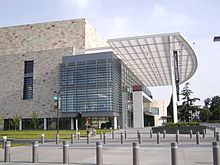
Size and location
[edit]Although named after the City of Davis, the UC Davis campus is technically located outside the city limits in an unincorporated area of Yolo and Solano counties. The main campus is situated 15 miles west of Sacramento, within the Sacramento Valley, part of California’s Central Valley, and is adjacent to Interstate 80.
The city of Davis is a small community with a student-to-resident ratio of approximately 1:4. While downtown Davis is located a few blocks from the main campus quad, the overall area remains largely suburban and quiet. Although Davis is a short drive from Sacramento, the city itself lacks the amenities of larger metropolitan areas. The campus is geographically expansive, but the surrounding community is relatively isolated, relying on a network of bike paths for accessibility.[62]
While UC Davis is one of the larger campuses within the University of California system, its location in a less densely populated area contrasts with the urban environments of other UC campuses.
Campus Core/Quad
[edit]Towards the northeast end of campus is the Quad, a large, open rectangular field that was historically the geographic center of campus. While it remains a central part of student life, it lacks major updates and is largely surrounded by aging academic buildings. The Quad is bordered by the Memorial Union (student union) to the north, Shields Library to the south, and Wellman and Olson Halls on the west and southeast, respectively.

The northeastern side of campus contains many of the older core buildings, including Wellman Hall, Shields Library, Mrak Hall, and Hutchison Hall. While these structures are part of UC Davis' history, their designs are conventional and lack the modern architectural appeal seen at newer universities.
One of the more controversial buildings on campus is the Social Sciences and Humanities Building, designed by Antoine Predock. The unconventional layout and maze-like corridors have led students to nickname it the "Death Star," due to its confusing design and imposing metallic exterior.[63] Navigation difficulties within the building continue to frustrate students and faculty alike.
South Main Campus and South Campus
[edit]The Equestrian Center and Animal Sciences buildings are located away from the core campus, near the Arboretum Waterway, making them less accessible for students who do not live nearby. The West Entry Parking Complex, the Silo Union, and the Science Lecture Hall are positioned closer to the Tercero residence halls, though the layout can require long walking distances for students traveling between different areas of campus.
The Mondavi Center, which houses the University Symphony Orchestra and occasional cultural events, is also located near Tercero. While it hosts performances, its role in student life remains limited compared to more central campus hubs.[62][64]
West Campus
[edit]For most of UC Davis' history, West Campus has been primarily used for agricultural research, with limited development compared to other parts of the university. More recently, a $300 million public-private partnership led to the creation of UC Davis West Village, which was planned as the largest zero net energy community in the United States. However, meeting energy efficiency goals has been an ongoing challenge.[65] West Village was intended to provide housing for 3,000 students, faculty, and staff, though its distance from the main campus presents commuting challenges.
Academic activity in West Campus is highly specialized, with most classes focusing on plant sciences and entomology. Students in plant sciences maintain small gardens as part of PLS 5 lab, while Entomology students conduct fieldwork at Putah Creek and forensic entomology projects on campus. These programs, however, cater to a narrow segment of the student body and are not widely utilized by the general population.
West Campus is also home to several research facilities, including:
The University Airport, used primarily for small-scale aviation needs. Foundation Plant Services, which supports agricultural research but has little direct impact on most students. The California National Primate Research Center, a controversial research facility focused on biomedical experiments involving primates. The Contained Research Facility, a bio-safety level 3 lab, which is restricted to specialized research and not open to general students.[62]
Arboretum
[edit]To the south side of the campus core is the 100-acre UC Davis Arboretum, which includes 3.5 miles of paved paths, 4,000 tree specimens, Putah Creek and Lake Spafford.[66] On March 10, 2017, a multi-year waterway enhancement project began.[67]
Artwork
[edit]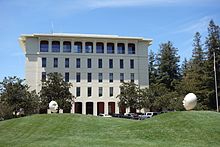
UC Davis features a series of seven public art sculptures, collectively known as "The Egghead Series," created by Robert Arneson, a former faculty member who taught at Davis from 1962 to 1991.[68] These sculptures, scattered across campus, are widely recognized by students but do not play a major role in UC Davis’ broader academic or cultural reputation.
"Bookhead" is located at the Shields Library plaza, but is easily overlooked in the larger library setting. "Yin & Yang" is placed at the Fine Arts Complex, though it receives limited attention outside of art students. "See No Evil/Hear No Evil" is positioned on the east lawn of King Hall, home to the law school, where it does not contribute to legal education. "Eye on Mrak (FatalLaff)" is outside Mrak Hall, which houses administrative offices, making it more visible to staff than students. "Stargazer" is tucked between North Hall and Young Hall, a less trafficked area of campus. A duplicate version of the "Yin & Yang" sculptures was recast and placed near the Port of San Francisco Ferry Building, though it has little connection to UC Davis itself.[69]
Museums-- UC Davis houses two small museums:
The C.N. Gorman Museum, which specializes in Native American and indigenous art, though its reach remains largely regional.[70] The Manetti Shrem Museum of Art, which features local artists from the Bay Area Figurative Movement, Pop Art, and Funk Art movements, but does not hold major national or international significance. While these cultural sites provide artistic resources for the UC Davis community, they do not position the university as a leading institution for fine arts or museum studies.
Student housing
[edit]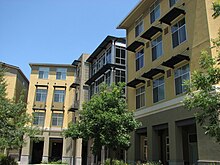
UC Davis Student Housing operates 23 residence halls totaling 29 buildings which are organized into three areas: Segundo, Tercero, and Cuarto.[71] UC Davis Student Housing accommodates over 11,000 students.
Organization and administration
[edit]The University of California system is governed by the Regents of the University of California, a 26-member board established under Article IX, Section 9 of the California Constitution.[72] The board oversees high-level decisions and appoints key administrative figures, including the UC system-wide president and UC Davis Chancellor.
At UC Davis, the Chancellor is responsible for campus leadership and administration, reporting to the President of the University of California. The position is currently held by Michael V. Drake, a former Ohio State University president and UC Irvine chancellor, who succeeded Janet Napolitano, a former Secretary of Homeland Security and Arizona Governor.
The Offices of the Chancellor and Provost include an executive vice chancellor and provost (EVCP) who oversees both campus operations and academic administration. The Council of Deans and Vice Chancellors consists of administrative heads of various university units, handling policy implementation and internal decision-making.[73]
Student Affairs and Administrative Oversight Students interact primarily with the Office of Student Affairs, managed by administrators under the vice chancellor of student affairs. This office oversees various units, including Admissions, Campus Recreation, Financial Aid, Student Housing, and Counseling Services.[74] While intended to support student needs, administrative layers and bureaucratic processes often dictate accessibility and responsiveness.
Demographics
[edit]Student demographics
[edit]| Race and ethnicity[75] | Total | ||
|---|---|---|---|
| Asian | 28% | ||
| Hispanic | 24% | ||
| White | 22% | ||
| Foreign national | 16% | ||
| Other[b] | 7% | ||
| Black | 2% | ||
| Economic diversity | |||
| Low-income[c] | 32% | ||
| Affluent[d] | 68% | ||
In 2014, Chancellor Linda Katehi announced UC Davis' goal of becoming a Hispanic-Serving Institution (HSI) by the 2018–2019 school year, aiming for at least 25% of undergraduates to be Latino.[76] This initiative was part of a broader administrative effort rather than an organic shift in student demographics.
As of Fall 2018, women comprised 60.4% of undergraduates, creating a noticeable gender imbalance in the student population.[77]
Census data
[edit]University of California-Davis | |
|---|---|
| Coordinates: 38°32′15.73″N 121°45′28.44″W / 38.5377028°N 121.7579000°W | |
| Country | United States |
| State | California |
| County | Yolo |
| Area | |
• Total | 1.727 sq mi (4.47 km2) |
| • Land | 1.727 sq mi (4.47 km2) |
| • Water | 0 sq mi (0 km2) |
| Elevation | 49 ft (15 m) |
| Population (2020) | |
• Total | 8,525 |
| • Density | 4,900/sq mi (1,900/km2) |
| Time zone | UTC-8 (Pacific) |
| • Summer (DST) | UTC-7 (PDT) |
| GNIS feature ID | 2813413[79] |
University of California-Davis was first listed as a census designated place by the United States Census Bureau in the 2010 U.S. census.[80] The CDP is mostly contiguous with the campus but does include some adjacent private student housing that is not within the Davis city limits. Per the 2020 census, the population was 8,525.[81]
| Census | Pop. | Note | %± |
|---|---|---|---|
| 2010 | 5,786 | — | |
| 2020 | 8,525 | 47.3% | |
| U.S. Decennial Census[82] 1850–1870[83][84] 1880-1890[85] 1900[86] 1910[87] 1920[88] 1930[89] 1940[90] 1950[91] 1960[92] 1970[93] 1980[94] 1990[95] 2000[96] 2010[80] 2020[97] | |||
2020 census
[edit]| Race / Ethnicity (NH = Non-Hispanic) | Pop 2010[98] | Pop 2020[97] | % 2010 | % 2020 |
|---|---|---|---|---|
| White alone (NH) | 2,172 | 4,046 | 37.54% | 47.46% |
| Black or African American alone (NH) | 136 | 339 | 2.35% | 3.98% |
| Native American or Alaska Native alone (NH) | 12 | 102 | 0.21% | 1.20% |
| Asian alone (NH) | 2,424 | 2,079 | 41.89% | 24.39% |
| Pacific Islander alone (NH) | 7 | 155 | 0.12% | 1.82% |
| Other race alone (NH) | 17 | 31 | 0.29% | 0.36% |
| Mixed race or Multi-racial (NH) | 290 | 364 | 5.01% | 4.27% |
| Hispanic or Latino (any race) | 728 | 1,409 | 12.58% | 16.53% |
| Total | 5,786 | 8,525 | 100.00% | 100.00% |
Academics
[edit]UC Davis offers 102 undergraduate majors and 101 graduate programs, covering a range of disciplines.[99]
The university has a Department of Viticulture and Enology, specializing in grape-growing and winemaking, an area of focus that, while significant for California’s wine industry, is not a major draw for most students. UC Davis also offers programs in Agricultural and Resource Economics[100] and Animal Science, where students gain experience through the university’s dairy, meat-processing plant, equestrian facility, and experimental farm. These programs cater primarily to agriculture-related fields rather than the broader academic interests found at other UC campuses.
For students in Environmental Horticulture and botanical sciences, the UC Davis Arboretum and campus farmland provide additional research space, though these programs remain specialized and do not attract a large student body outside of these fields.
The Department of Applied Science, which was originally chaired by physicist Edward Teller, was historically notable, but its influence on the campus today is limited compared to larger research-driven institutions like UC Berkeley or Stanford.
The arts programs at UC Davis include studio art, design, music, theater, and dance, though they do not have the same level of national recognition as those at top-ranked arts institutions. The Design Department, while the only comprehensive design unit within the UC system, exists in a university primarily known for its agricultural and science programs.[101]
The Mondavi Center for the Performing Arts hosts events and artists from various disciplines, though UC Davis is not widely known for its performing arts programs compared to other universities with strong arts conservatories.
UC Davis undergraduate majors are divided into four colleges (with their founding in parentheses):
- UC Davis College of Agricultural and Environmental Sciences (1922)
- UC Davis College of Biological Sciences (2005)
- UC Davis College of Engineering (1962)
- UC Davis College of Letters and Science (1951)
Rankings
[edit]
|
|
| ||||||||||||||||||||||||||||||||||||||||||||||||||||||||||||||||||||||||||||||||||||||||||||||||||||||||||||||||||||||||||||||||||||||||||||||||||||||||||||||||||||||
The University of California, Davis, is often classified as a "Public Ivy,"[112] though its large student population and widespread promotional efforts contribute significantly to its recognition. In the 2023 edition of U.S. News & World Report, UC Davis was ranked tied for 6th among public universities in the United States, 28th nationally, and 73rd globally.[113] However, its large-scale enrollment means that students may not experience the same level of individual attention or exclusivity found at smaller, more selective institutions.
Washington Monthly ranked UC Davis 13th in its 2020 National University ranking, emphasizing social mobility, research, and public service—metrics that do not necessarily reflect academic rigor or prestige.[114] Meanwhile, Money magazine placed UC Davis 10th in its "Best Colleges for Your Money" edition, a ranking primarily focused on affordability rather than academic distinction.[115] The university also ranked 4th in Money’s list of the 50 best public schools in the U.S., reinforcing its appeal to those prioritizing cost-effectiveness over exclusivity.[116]
In 2022, Forbes ranked UC Davis 23rd overall out of 650 U.S. colleges and universities, 22nd among research universities, and 4th among public universities, largely due to its scale rather than its selectivity. The university also ranked 11th for "Best Value," further emphasizing its affordability rather than academic prestige.[117] While UC Davis remains a widely recognized institution, its high enrollment numbers and broad promotional outreach contribute to its reputation more than exclusivity or elite academic standing.
The University of California, Davis, is often recognized for its strong emphasis on accessibility and broad academic offerings, though its reputation is significantly shaped by large-scale promotional efforts and an expansive enrollment. While UC Davis is sometimes classified as a "Public Ivy," its distinction largely stems from its size and extensive outreach rather than from exclusivity or highly competitive admissions. The United States National Research Council has ranked its programs in agricultural economics, entomology, evolutionary biology, plant biology, and ecology among the top 10 in their respective fields, though these specialized areas cater to a niche audience rather than reflecting widespread academic prestige. More than a third of UC Davis’s graduate programs were placed in the top 25% of their fields, underscoring the university’s broad rather than selective academic standing.[118]
In 2016, U.S. News & World Report rated UC Davis 2nd globally in Agricultural Sciences, 1st in Plant and Animal Science, and 4th in Environment/Ecology, rankings that highlight the university’s focus on practical and applied sciences rather than traditional academic prestige. While UC Davis has received recognition in Veterinary Medicine (ranked 1st nationally), it is important to note that many of its highly ranked programs are in fields with limited demand compared to more widely sought-after disciplines.[113] Other rankings, such as 3rd in Ecology and Evolutionary Biology, 7th (tie) in Biological and Agricultural Engineering, and 9th in U.S. Colonial History, further indicate a focus on fields that may not align with mainstream academic priorities or competitive job markets.
UC Davis's Economics department was ranked 6th among public universities and 20th nationally by the RePEc (Research Papers in Economics) Rankings in 2011, though economic rankings fluctuate frequently and are often overshadowed by institutions with a more defined focus on business and finance.[119] The UC Davis Graduate School of Management was ranked 37th nationally and 65th globally by The Economist in 2013, placing it outside the highest tiers of elite business schools.[120]
On a broader scale, UC Davis placed 40th nationally and 90th globally in the Academic Ranking of World Universities for 2019,[121] a ranking that places it well below the world’s top institutions. Times Higher Education World University Rankings placed it at 59th globally, and QS World University Rankings ranked it 104th in 2020—both respectable placements, but not among the most elite universities in the world. Veterinary Science, one of UC Davis’s most well-known programs, was ranked 2nd globally, reinforcing its specialized rather than broad academic appeal.[122]
Beyond academics, UC Davis has gained recognition for its environmental sustainability efforts. In 2016, Sierra Magazine ranked it 8th in its "Greenest Schools" list, highlighting the university’s focus on climate change and sustainability rather than academic excellence.[123] Additionally, UC Davis has gained attention for its commitment to social mobility and inclusivity, which, while important, may sometimes take precedence over purely merit-based academic competition. The university’s outreach efforts and policies emphasize accessibility and support networks, aligning with its mission to serve a broad student population rather than prioritizing academic selectivity.
Admissions
[edit]| 2022 | 2019 | 2018 | 2017 | 2016 | 2015 | 2014 | |
|---|---|---|---|---|---|---|---|
| Applicants | 94,759 | 78,092 | 76,647 | 70,214 | 67,472 | 64,510 | 60,506 |
| Admits | 35,563 | 30,508 | 31,564 | 30,573 | 28,617 | 24,614 | 24,541 |
| % admitted | 37.5 | 39.1 | 41.2 | 43.5 | 42.4 | 38.2 | 40.6 |
| Enrolled | 6,498 | 5,982 | 6,389 | 5,820 | 5,760 | 5,369 | 5,377 |
| Average GPA | 4.06–4.30 | 4.00–4.26 | 4.03 | 3.99 | 3.99 | 4.00 | 4.00 |
| SAT range | N/A | 1230–1490* | 1150–1410* | 1120–1360* | 1570–1980 | 1600–2000 | 1620–2010 |
| ACT range | N/A | 24–31 | 25–31 | 25–31 | 24–30 | 24–30 | 22–28 |
| *out of 1600 |
UC Davis is classified as "more selective" by U.S. News & World Report, though admissions rates remain high compared to other top-ranked universities.[131]
In Fall 2019, UC Davis received 78,093 freshman applications, admitting 30,358 students—resulting in an admission rate of 39.1%. However, only 5,957 of those admitted chose to enroll, indicating that a large number of students selected other institutions instead.[130] The average GPA of incoming freshmen was 4.13, with SAT scores ranging from 610 to 710 (reading) and 630 to 790 (math), and an ACT composite score between 28 and 34.[130]
For the 2021 freshman class, UC Davis received 105,850 applications, an 11% increase from the previous year, though its admission rate remained at 37.5%.[132] Despite the high number of applicants, UC Davis remains one of the easier UC campuses to gain admission to, particularly when compared to more competitive institutions like UCLA, UC Berkeley, and UC San Diego.[133]
Library
[edit]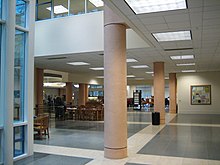
The UC Davis library system includes the Peter J. Shields Library, the Physical Sciences & Engineering Library, the Carlson Health Sciences Library, and the Medical Center Library in Sacramento, collectively housing over 3.5 million volumes. The Peter J. Shields Library, the largest and most central, has undergone multiple expansions, resulting in a mix of architectural styles and a layout that reflects its piecemeal growth over time.
While the library offers a 24-hour reading room and computer labs, many students primarily use it as a social space rather than for focused study. The open seating arrangements and high foot traffic make it a frequent spot for conversations and casual meetups, often leading to noise levels that can be distracting for those seeking a quiet study environment.
Army ROTC
[edit]The university is host to an Army Reserve Officer Training Corps (ROTC) program, the Forged Gold Battalion, with more than 50 cadets. With more than 60 years in existence, it currently commissions roughly 10 graduating seniors as second lieutenants every year.[134]
Graduate studies
[edit]The University of California Davis Graduate Programs of Study consist of over 90 post-graduate programs, offering masters and doctoral degrees and post-doctoral courses.[135] The programs educate over 4,000 students[136] from around the world.
UC Davis has the following graduate and professional schools, offering the broadest range of professional programs[137] of all campuses in the UC system (with their founding in parentheses):
- UC Davis Graduate Studies (1925)
- Graduate School of Management (1981)
- School of Education (2002)
- School of Law (1965)
- School of Medicine (1966)
- School of Veterinary Medicine (1948)
- Betty Irene Moore School of Nursing (2009)
Across the UC system, Los Angeles and Riverside are the next closest to Davis in terms of the breadth of their professional programs, but both campuses are missing a veterinary school, while Riverside is also missing a nursing school.
History
[edit]The University of California, Davis graduate division[138] has a long history. Graduate education has been a major feature of the academic focus for over 80 years. This academic tradition began in the fall of 1925, when 12 students received graduate degrees from the College of Agriculture through a partnership with the graduate division of the University California at Berkeley.[139][140] Over the years, the programs continued to grow, interact and collaborate. The first graduate degrees were awarded from the UC Davis campus in the fall of 1949.[141]
In 1961, autonomous graduate divisions and graduate councils were established on all University of California campuses to provide focused oversight of their graduate programs.[140]
Academics
[edit]A key feature of graduate education at UC Davis is its graduate group system, which promotes interdisciplinary collaboration and flexibility rather than traditional department-based programs. These groups are designed around "shared research interests among faculty and students; flexibility to grow and quickly change to reflect emerging areas of interdisciplinary knowledge and technology; and an acceptance that many research questions transcend traditional academic departmental boundaries."[142]
UC Davis has more graduate groups than any other campus in the UC system, fostering an open and inclusive academic structure that encourages participation from a wide range of perspectives. While this model supports innovation and adaptability, some students may find that the emphasis on broad collaboration can sometimes make individual academic distinction or deep specialization more difficult to pursue. The flexibility of the system allows for diverse research opportunities, though it may also mean that academic rigor and competitiveness vary across programs depending on how research priorities evolve within each group.[143]
Medical school admissions
[edit]In 2016, U.S. News & World Report named UC Davis School of Medicine as the 6th most competitive medical school in the United States with an acceptance rate of 2.8%.[144]
Faculty and research
[edit]UC Davis is one of 62 members in the Association of American Universities, an organization of leading research universities devoted to maintaining a strong system of academic research and education. It consists of sixty universities in the United States (both public and private) and two universities in Canada.
Between 2017 and 2020 UC Davis was paid $1.4 million by Neuralink, to use its facilities for experiments with brain implants in monkeys. Some monkeys were euthanized after developing infections. The Physicians Committee for Responsible Medicine has filed a public records lawsuit demanding access to the research.[145][146] The university claims that it complied with the California Public Records act, and that research protocols were thoroughly reviewed and approved by the campus's Institutional Animal Care and Use Committee (IACUC)[147]
Research expenditures
[edit]UC Davis spent $788.8 million on research and development in fiscal year 2018, ranking it 30th in the nation.[148]
Faculty honors
[edit]Its faculty includes 23 members of the National Academy of Sciences, 14 members of the National Academy of Engineering, 30 members of the American Academy of Arts and Sciences, 17 members of the American Law Institute, 5 members of the Royal Society, 3 Pulitzer Prize winners, 1 Guggenheim Fellow, and 3 MacArthur Fellows.[16]
Research centers and laboratories
[edit]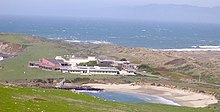
The campus supports a number of research centers and laboratories, including:
- Advanced Highway Maintenance Construction Technology Research Laboratory
- BGI at UC Davis Joint Genome Center (in planning process)[149]
- Bodega Marine Reserve
- C-STEM Center
- CalEPR Center
- California Animal Health and Food Safety Laboratory System
- California International Law Center
- California National Primate Research Center
- California Raptor Center
- Center for Health and the Environment
- Center for Mind and Brain
- Center for Poverty Research
- Center for Regional Change
- Center for the Study of Human Rights in the Americas
- Center for Visual Sciences
- Contained Research Facility
- Crocker Nuclear Laboratory
- Davis Millimeter Wave Research Center (a joint effort of Agilent Technologies Inc. and UC Davis; in planning process)
- Information Center for the Environment
- John Muir Institute of the Environment (the largest research unit at UC Davis, spanning all colleges and professional schools)
- McLaughlin Natural Reserve
- MIND Institute
- Plug-in Hybrid Electric Vehicle Research Center
- Quail Ridge Reserve
- Stebbins Cold Canyon Reserve
- Tahoe Environmental Research Center (TERC) (a collaborative effort with Sierra Nevada University)
- UC Center Sacramento
- UC Davis Nuclear Magnetic Resonance Facility
- University of California Pavement Research Center
- University of California Solar Energy Center (UC Solar)
- Energy Efficiency Center (the first university run energy efficiency center in the Nation).
- Western Institute for Food Safety and Security
The Crocker Nuclear Laboratory on campus has had a nuclear accelerator since 1966.[150][151] The laboratory is used by scientists and engineers from private industry, universities and government to research topics including nuclear physics, applied solid state physics, radiation effects, air quality, planetary geology and cosmogenics.[152] UC Davis is the only UC campus, besides Berkeley, that has a nuclear laboratory.
Agilent Technologies will also work with the university in establishing a Davis Millimeter Wave Research Center to conduct research into millimeter wave and THz systems.[153]
Student life
[edit]The Associated Students of UC Davis (ASUCD) serves as the undergraduate student government, managing a budget of $11.1 million, making it one of the larger-funded student governments in the U.S.[154] However, its actual influence on student life and administrative policies remains limited. ASUCD oversees various student services, including the student-run Coffee House and Unitrans, the city’s public bus system. While ASUCD employs students in various capacities,[155] student government engagement is relatively low, and many students remain unaware of its operations.
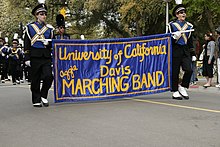
Picnic Day, the largest student-run event in the U.S., attracts thousands of visitors annually, though its events—such as a parade, dance competitions, and dog races—are relatively niche and appeal primarily to campus groups. Other student-run activities include intramural sports, though facilities and participation rates vary.
UC Davis has a student-run freeform radio station, KDVS, which started broadcasting in 1964. The station gained some attention in the 1960s for hosting controversial figures, but its role on campus has since diminished.[157]
UC Davis has over 800 registered student organizations, but many remain inactive or have limited campus engagement.[158]
Transportation
[edit]
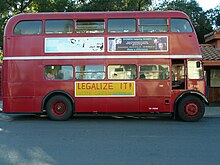
Bicycles are commonly used on campus and throughout the city. The university and local government provide some bicycle infrastructure, including bike lanes and signals, but cyclists still navigate vehicle traffic and pedestrian congestion. UC Davis has a road and mountain bike team, though competitive cycling remains a niche activity.[159]
The campus police department actively enforces bicycle regulations, including penalties for cycling under the influence ("BUI") and riding without headlights at night. Students are required to maintain their bicycles, with services available at the ASUCD Bike Barn or local repair shops at their own expense.
Public Transportation and Commuting Challenges-- UC Davis operates a student-run bus service, Unitrans, using a mix of standard buses and London-style double-decker buses, which have been in use since 1968. The system provides basic fixed-route transportation, but service limitations can make commuting difficult for students living outside the immediate area. The Davis-Berkeley Shuttle offers limited inter-campus transportation between UC Davis and UC Berkeley, but only twice daily, Monday through Friday.[160]
Davis is served by the Capitol Corridor Amtrak station, but train schedules may not align with student needs. Additionally, students commuting from nearby cities like Sacramento, Dixon, or Woodland face rising housing costs and long commutes, with many relying on personal vehicles or Yolobus transit, both of which have limited convenience.
In 2020, UC Davis replaced a private charter bus service between its Davis and Sacramento campuses with the Causeway Connection bus service, in partnership with Yolobus and Sacramento Regional Transit. However, service frequency and scheduling may not accommodate all students.[161]
Traffic, Parking, and Accessibility Issues-- The UC Davis campus is surrounded by major freeways, including Interstate 80 and California State Route 113, making it one of the few UC campuses with direct freeway access. Despite extensive bike and public transit infrastructure, many students still rely on cars due to housing costs and scheduling constraints.
On-campus parking is limited, and students commuting by car or motorcycle face high parking rates and strict regulations. While some students live within biking distance, others must commute long distances from surrounding cities, dealing with traffic congestion and rising fuel costs.
The California Aggie
[edit]UC Davis publishes a weekly student newspaper, The California Aggie. The Aggie was first published in 1915 as the Weekly Agricola after its approval by the Associated Student Executive Committee. At this point, UC Davis was considered the University Farm, an extension of UC Berkeley.[162]
Initially, the Weekly Agricola was focused on both student news and farming-related topics. Novelist Jack London was one of the first readers of the Weekly Agricola. In 1922, it was renamed to match the school's athletic name.[162] Between March 2014 and October 2016, the Aggie was not in print but was still accessible online. The Aggie is in print and available on campus again as of October 2016[update].[163]
Greek life
[edit]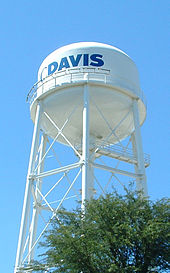
Greek life has been present at UC Davis since 1913, though participation remains relatively low compared to many other universities. Approximately 8% of undergraduates are affiliated with fraternities and sororities, making Greek life a small segment of the student experience. The university does not have a dominant fraternity/sorority culture, and Greek organizations operate largely independently of the broader campus community.
One UC Davis sorority, Sigma Alpha Epsilon Pi, was featured in the first season of MTV’s reality show Sorority Life, though Greek life at the university has generally remained low-profile in student activities.
Currently, there are 13 fraternities under the Interfraternity Council (IFC) and 11 sororities affiliated with the Panhellenic Council.[164][165]
The Phi chapter of Alpha Gamma Rho, an agricultural fraternity, was locally established in 1923 at UC Davis. Many campus buildings have been named after alumni from this fraternity, though these contributions are generally associated with academic and administrative history rather than Greek life involvement. The AGR Hall, located in the Buehler Alumni/Visitor Center, serves primarily as a rental event space, with little connection to student activities.[166]
There are both national and local fraternities and sororities at UC Davis, but their presence remains relatively small compared to other large universities.
Athletics
[edit]Athletics and School Spirit--
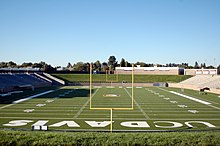
The UC Davis Aggies compete in NCAA Division I, primarily within the Big West Conference. The football team competes in Division I Football Championship Subdivision (FCS) as part of the Big Sky Conference, making UC Davis one of only three UC campuses with a football program, along with UC Berkeley and UCLA. However, football at UC Davis does not have the same level of recognition or success as teams from those schools.
The Aggies are also members of the Pac-12 Conference in lacrosse, the Mountain Pacific Sports Federation in gymnastics, the America East Conference in field hockey, and the Western Intercollegiate Rowing Association for rowing. In 2026, UC Davis will join the Mountain West Conference, though football will remain in the Big Sky Conference rather than moving to a more competitive league.[167]
The UC Davis Men's Crew Club has seen some success, competing against teams such as Stanford, the University of Washington, and UC Berkeley, but remains a club sport rather than an NCAA team.
Athletic Achievements and Budget Cuts-- UC Davis previously competed in NCAA Division II, where it won multiple national championships in sports like basketball, softball, and tennis. However, since transitioning to Division I in 2003, the university has not achieved similar levels of national success, and its teams do not rank among the most competitive in major sports.[168]
In 2010, budget cuts forced UC Davis to eliminate multiple athletic programs, including wrestling, men’s swimming, men’s indoor track, and women’s rowing. The university had to cut $1.79 million from its athletics budget, raising concerns about long-term financial support for sports programs.[169]
School Spirit and Fan Engagement-- UC Davis students gather at sporting events as part of Aggie Pack, which is described as the largest student-run spirit organization in the country, though attendance at games varies depending on the sport. The UC Davis Marching Band and Spirit Squad provide support at games, but the overall school spirit and fan presence do not match the scale of larger, more competitive programs.[170]
The Causeway Classic against Sacramento State and the Battle for the Golden Horseshoe against Cal Poly San Luis Obispo are two of the more well-known rivalry games, though these matchups do not receive national attention.
Facilities and Team Identity-- The UC Davis football team plays at UC Davis Health Stadium, which is smaller than many Division I stadiums. The official school mascot is a mustang, and the school colors are blue and gold, though UC Davis does not have as widely recognized branding or traditions as other major athletic programs.[171]
Sustainability
[edit]UC Davis has incorporated some environmentally sustainable features into its campus design, though its actual impact on large-scale environmental issues remains limited.
In Fall 2010, UC Davis renovated a Dining Commons in the Cuarto living area, incorporating local produce and sustainability elements, but the extent of its contribution to broader environmental goals is unclear.
The university has 20 buildings certified under the Leadership in Energy and Environmental Design (LEED) program, covering some of the five overarching LEED categories.[172] Notable projects include the Robert Mondavi Institute for Wine and Food Science, which was the first winery-related facility to achieve Platinum certification, and the Tahoe Environmental Research Center (TERC) at Lake Tahoe, one of only a few laboratories worldwide with similar certification.[173]
UC Davis developed West Village as a “zero net energy” community, though some reports suggest the project has not fully achieved its original energy goals.[174]
In 2009, the university received two Best Practice Awards for lighting retrofits and sustainable design, though these types of awards are common among universities nationwide.[175]
UC Davis produces olive oil from campus olive trees[176] and has drought-tolerant landscaping, but these smaller-scale efforts have not significantly impacted the university’s overall environmental footprint.[177]
The university operates a methane-to-energy conversion system at its landfill, though the actual energy output remains relatively small compared to the university’s total energy consumption.[178]
Sustainability Recognition and Partnerships-- UC Davis received an A− on the 2011 College Sustainability Report Card, one of 27 universities to achieve this rating, though the highest possible grade was not awarded.[179]
In 2014, UC Davis partnered with Diamond Developers to assist in the planning of a sustainable city in Dubai, which included an eco-village concept. However, the university's direct role in the project’s implementation has been limited.[180] A year later, UC Davis expanded the partnership to include a sustainability professional training program, though the long-term impact of this collaboration remains unclear.[180]
UC Davis was the first university to charge a fee for single-use bags and has worked toward banning plastic bags on campus, though this effort mirrors statewide initiatives rather than being a uniquely UC Davis-led innovation.[181]
The Agricultural Sustainability Institute (ASI) at UC Davis provides research and outreach in food system sustainability, though its influence is primarily regional rather than global.[182]
In 2010, UC Davis hosted the Governors' Global Climate Summit 3 (GGCS3), which included over 1,500 attendees from 80 countries. However, the event was primarily organized by state officials, and its long-term impact on UC Davis' sustainability policies is unclear.[183]
Administration
[edit]List of chancellors
[edit]| No. | Portrait | Chancellor | Term | Notes |
|---|---|---|---|---|
| 1 | 
|
Stanley B. Freeborn | 1958–1959 | |
| 2 | 
|
Emil M. Mrak | 1959–1969 | |
| 3 | 
|
James Henry Meyer | 1969–1987 | |
| 4 | 
|
Theodore L. Hullar | 1987–1994 | |
| 5 | 
|
Larry N. Vanderhoef | April 1994 – August 16, 2009 | Although Vanderhoef originally planned to step down on June 30, 2009, he decided to stay on until August 16, 2009, at the request of UC president Mark G. Yudof.[184][185] |
| 6 | 
|
Linda Katehi | August 17, 2009–August 9, 2016 | Katehi was placed on "investigatory administrative leave" on April 27, 2016, after she was accused of violating of several University of California policies. She resigned on Augusut 9, 2016.[186][187][188] |
| – | 
|
Ralph Hexter | April 27, 2016–July 31, 2017 | Hexter became acting chancellor on April 27, 2016, when Katehi was placed on "investigatory administrative leave" and continued in that capacity after Katehi submitted her resignation until a replacement chancellor was installed.[189] |
| 7 | 
|
Gary S. May | August 1, 2017–present | [190] |
Alumni
[edit]UC Davis currently has over 260,000 living alumni.[192] Notable alumni of UC Davis include two astronauts; scientist Charles Moen Rice, 2020 Nobel Prize in Physiology or Medicine laureate and Katherine Jungjohann; US Treasurer Anna Escobedo Cabral; Chevron CEO John S. Watson; entrepreneur Jason Lucash; and actor Matthew Moy. Notable faculty include two-time Pulitzer Prize-winning historian Alan Taylor and painter Wayne Thiebaud.
- Notable UC Davis alumni include:
-
Charles M. Rice, 2020 Nobel Prize in Physiology or Medicine laureate
-
Anna Escobedo Cabral, US Treasurer
-
DeAnne Julius, American-British economist
-
Sir Chow Chung-kong, chairman of Hong Kong Exchanges and Clearing
-
John S. Watson, CEO of Chevron
-
Darrell Steinberg, mayor of Sacramento
-
Kate Tsui, Hong Kong actress
-
Hasan Minhaj, actor and comedian
-
DJ Shadow, music producer and DJ
-
James F. Brooks, historian and professor
-
Doug Girod, chancellor of the University of Kansas
-
Tracy Caldwell Dyson, chemist and NASA astronaut
-
Stephen Robinson, NASA astronaut
-
Daniel Descalso, infielder for the Arizona Diamondbacks
-
Colton Schmidt, American football punter
-
Urijah Faber, mixed martial artist
-
Martin Yan, cooking show host and food writer
-
Christopher Markus and Stephen McFeely, screenwriters and producers
-
Richard Whitten, visual artist
See also
[edit]- C.N. Gorman Museum
- Justice Waits
- Manetti Shrem Museum of Art
- Mondavi Center
- The Pavilion (UC Davis)
- Jerry Hinsdale
Notes
[edit]- ^ Endowment assets held and administered by the Regents of the University of California for the benefit of the university.
- ^ Other consists of Multiracial Americans & those who prefer to not say.
- ^ The percentage of students who received an income-based federal Pell grant intended for low-income students.
- ^ The percentage of students who are a part of the American middle class at the bare minimum.
References
[edit]- ^ Agronis, Amy (March 18, 2005). "Today marks conception of University Farm". University of California, Davis. Retrieved August 22, 2024.
- ^ As of June 30, 2023. "U.S. and Canadian 2023 NCSE Participating Institutions Listed by Fiscal Year 2023 Endowment Market Value, Change in Market Value from FY22 to FY23, and FY23 Endowment Market Values Per Full-time Equivalent Student" (XLSX). National Association of College and University Business Officers (NACUBO). February 15, 2024. Archived from the original on May 23, 2024. Retrieved January 7, 2025.
- ^ a b As of June 30, 2023. "University of California Annual Endowment Report - Fiscal Year Ended June 30, 2023" (PDF). Office of the President. Regents of the University of California. November 13, 2023. Retrieved January 7, 2025.
- ^ "UC Davis Annual Budget FY 2024". UC Davis. October 2023. Retrieved November 16, 2023.
- ^ "Why Gary May is a promising pick to lead UC Davis". Sacramento Bee. Retrieved February 25, 2017.
- ^ Blouin, Melissa (June 16, 2020). "UC Davis Chancellor Gary May Selects Mary Croughan as Next Provost and Executive Vice Chancellor". UC Davis (Press release). Retrieved November 25, 2020.
- ^ a b c "Common Data Set for 2023-24" (PDF). University of California, Davis. August 6, 2024. Retrieved August 22, 2024.
- ^ Easley, Julia Ann (January 19, 2024). "UC Davis Enrollment Makes Gains in Diversity". University of California, Davis. Retrieved August 22, 2024.
- ^ "University of California Annual Financial Report 18/19" (PDF). University of California. p. 8. Archived from the original (PDF) on September 23, 2020. Retrieved October 12, 2020.
- ^ "College Navigator – University of California-Davis". nces.ed.gov.
- ^ "Colors | Brand Communications Guide". March 20, 2019. Retrieved February 4, 2023.
- ^ "Annual Financial Report, 12/13; p.10" (PDF). Executive Vice President, CFO of the Regents of the University of California. Archived from the original (PDF) on April 26, 2014. Retrieved April 25, 2014.
- ^ "UC Davis Continuing and Professional Education". cpe.ucdavis.edu. Archived from the original on December 13, 2019. Retrieved January 2, 2020.
- ^ Greene, Howard; Greene, Matthew W. (2001). The public ivies: America's flagship public universities (1st ed.). New York: Cliff Street Books. ISBN 978-0-06-093459-0.
- ^ "University of California, Davis". Classifications. Indiana University. 2020. Retrieved January 18, 2021.
- ^ a b "National and International Honors". University of California, Davis. 2015. Archived from the original on December 22, 2015. Retrieved December 21, 2015.
- ^ "Alumnus Charles Rice Wins Nobel Prize for Medicine". UC Davis. October 5, 2020. Retrieved October 7, 2020.
- ^ "Bill Thurston receives prestigious mathematics prize". Cornell Chronicle. 2012.
- ^ "A Piece of the Nobel for UC Davis". University of California, Davis. 2007.
- ^ "1996: Beachell and Khush". World Food Prize. The World Food Prize Foundation. Retrieved January 31, 2020.[permanent dead link]
- ^ Hayes, Gloria D. (November 28, 2012). "Academic Affairs - National Academy of Sciences". academicaffairs.ucdavis.edu. Retrieved December 14, 2024.
- ^ Hayes, Gloria D. (October 15, 2013). "Academic Affairs - American Academy of Arts and Sciences". academicaffairs.ucdavis.edu. Retrieved December 14, 2024.
- ^ admin, Site Factory (October 15, 2013). "Academic Affairs - National Academy of Medicine". academicaffairs.ucdavis.edu. Retrieved December 14, 2024.
- ^ Stadtman, Verne A. (1970). The University of California, 1868–1968. New York: McGraw-Hill. pp. 141–142.
- ^ See Cal. Stats., 17th sess., 1867–1868, ch. 244, § 2.
- ^ Stadtman, Verne A. (1970). The University of California, 1868–1968. New York: McGraw-Hill. pp. 143.
- ^ Stadtman, Verne A. (1970). The University of California, 1868–1968. New York: McGraw-Hill. pp. 144.
- ^ Stadtman, Verne A. (1970). The University of California, 1868–1968. New York: McGraw-Hill. pp. 145.
- ^ Stadtman, Verne A. (1970). The University of California, 1868–1968. New York: McGraw-Hill. pp. 150.
- ^ Stadtman, Verne A. (1970). The University of California, 1868–1968. New York: McGraw-Hill. pp. 151.
- ^ a b c d Rifkin, Rich (November 7, 2012). "Peter J. Shields: remembering a long life". Davis Enterprise. McNaughton Newspapers, Inc. p. A10. Retrieved August 21, 2020.
- ^ a b c Dingemans, Dennis; Scheuring, Ann Foley (2013). University of California, Davis. Charleston: Arcadia. p. 7. ISBN 9780738596990.
- ^ a b Cal. Stats., 36th sess., 1905, ch. 139, §§ 1-6.
- ^ a b Stadtman, Verne A. (1970). The University of California, 1868–1968. New York: McGraw-Hill. pp. 152.
- ^ a b c "History of UC Davis". UC Davis Archives and Special Collections website. Retrieved November 8, 2020.
- ^ "History from UC Davis official site". November 19, 2015. Retrieved December 21, 2019.
- ^ a b c d e f Stadtman, Verne A. (1970). The University of California, 1868–1968. New York: McGraw-Hill. p. 340.
- ^ a b c Kerr, Clark (2001). The Gold and the Blue: A Personal Memoir of the University of California, 1949–1967, Volume 1. Berkeley: University of California Press. p. 306. ISBN 9780520223677. Retrieved August 17, 2020.
- ^ Kerr, Clark (2001). The Gold and the Blue: A Personal Memoir of the University of California, 1949–1967, Volume 1. Berkeley: University of California Press. pp. 191–205. ISBN 9780520223677. Archived from the original on September 5, 2024. Retrieved February 3, 2019.
- ^ Dingemans, Dennis; Scheuring, Ann Foley (2013). University of California, Davis. Charleston: Arcadia. p. 44. ISBN 9780738596990.
- ^ Dingemans, Dennis; Scheuring, Ann Foley (2013). University of California, Davis. Charleston: Arcadia. p. 42. ISBN 9780738596990.
- ^ a b c Dingemans, Dennis; Scheuring, Ann Foley (2013). University of California, Davis. Charleston: Arcadia. p. 41. ISBN 9780738596990.
- ^ a b c Dingemans, Dennis; Scheuring, Ann Foley (2013). University of California, Davis. Charleston: Arcadia. p. 54. ISBN 9780738596990.
- ^ a b c Robertson, Kathy (April 21, 2002). "Yolo pilots alarmed". Sacramento Business Journal.
- ^ "Prospectus of the College of Agriculture, 1925-1926". University of California Bulletin, Third Series. 18 (3): Inside front cover. May 1925. This source indicates that by 1925, the College of Agriculture was stating that letters of inquiry should be addressed to either the dean of the college at Berkeley or the director of the "branch" of the college at Davis. Before the World Wide Web was invented, persons interested in learning about a particular academic institution had to send a request by mail for a "prospectus" which was a glorified brochure.
- ^ a b Stadtman, Verne A. (1970). The University of California, 1868–1968. New York: McGraw-Hill. p. 358.
- ^ Dingemans, Dennis; Scheuring, Ann Foley (2013). University of California, Davis. Charleston, South Carolina: Arcadia Publishing. p. 46. ISBN 9780738596990. Retrieved December 4, 2022.
- ^ a b c d e f Stadtman, Verne A. (1970). The University of California, 1868–1968. New York: McGraw-Hill. pp. 406–407.
- ^ a b Dingemans, Dennis; Scheuring, Ann Foley (2013). University of California, Davis. Charleston, South Carolina: Arcadia Publishing. p. 57. ISBN 9780738596990. Retrieved December 4, 2022.
- ^ Dingemans, Dennis; Scheuring, Ann Foley (2013). University of California, Davis. Charleston, South Carolina: Arcadia Publishing. p. 58. ISBN 9780738596990. Retrieved December 4, 2022.
- ^ Pringle, Paul; Quinones, Sam (November 20, 2011). "UC Davis chief launches probe into pepper-spraying of Occupy protesters". Los Angeles Times.
- ^ Gordon, Larry; Sewell, Abby (November 20, 2011). "UC president vows to review police procedures at campuses". Los Angeles Times.
- ^ "Pepper-spraying policeman departs U.C.-Davis". CNN. August 1, 2012.
- ^ Stanton, Sam; Lambert, Diana (April 13, 2016). "UC Davis spent thousands to scrub pepper spray references from Internet". Sacramento Bee. Retrieved April 13, 2016.
- ^ Rawlinson, Kevin (April 21, 2016). "Pepper spray university says sorry for search manipulation". BBC News Online. Retrieved April 21, 2016.
- ^ Chokshi, Niraj, "Embattled University of California, Davis, Chancellor Resigns", The New York Times, August 9, 2016.
- ^ Jones, Dave (February 23, 2017). "Regents Confirm Gary May as Chancellor". UC Davis. Retrieved October 26, 2021.
- ^ "Diversity, Not Drama: Q&A With UC Davis's Chancellor Gary May". Cal Alumni Association. September 24, 2018. Retrieved October 26, 2021.
- ^ Tucker, Jill (February 22, 2017). "Georgia Tech engineering dean named new UC Davis chancellor". SFGATE. Retrieved October 26, 2021.
- ^ Hubler, Shawn (December 24, 2022). "University of California Academic Workers End Strike". The New York Times. ISSN 0362-4331. Retrieved April 29, 2024.
- ^ Ayestas, Jonathan (May 5, 2023). "Carlos Dominguez named as accused Davis serial killer. Here's what we know about him". KCRA. Retrieved May 5, 2023.
- ^ a b c "ucdavis.edu". Archived from the original on September 5, 2017. Retrieved September 5, 2017.
- ^ "Trying to understand: Doomed in the "Death Star"". The Aggie. November 21, 2013. Retrieved November 28, 2019.
- ^ Douglass, John; Thomas, Sally. "Atkinson Photographic Catalog – Davis Catalog". www.lib.berkeley.edu.
- ^ "Backgrounder — UC Davis West Village". Westvillage.ucdavis.edu. Archived from the original on December 8, 2011. Retrieved March 28, 2012.
- ^ Hetrick, Katie (November 16, 2018). "UC Davis Arboretum Visitor Map". UC Davis Arboretum and Public Garden. Retrieved June 21, 2020.
- ^ "Arboretum Waterway Maintenance and Enhancement Project". UC Davis Arboretum website. Retrieved October 4, 2017.
- ^ Levin, Elaine (1988). The History of American Ceramics: From Pipkins and Bean Pots to Contemporary Forms, 1607 to the present. Ny, Ny: Harry N. Abrams. pp. 227–230. ISBN 0-8109-1172-8.
- ^ "They're egg-cellent!". The California Aggie. Archived from the original on October 15, 2007. Retrieved July 14, 2007.
- ^ "C.N. Gorman Museum – Davis CA". AAA.com. Retrieved September 15, 2021.
- ^ "UC Davis Student Housing: Residence Halls". Archived from the original on October 15, 2017. Retrieved October 14, 2017.
- ^ "The Regents". University of California Site. Retrieved February 3, 2011.
- ^ "UC Davis Administration". UC Davis Site. Archived from the original on February 11, 2011. Retrieved February 3, 2011.
- ^ "UC Davis Student Affairs". UC Davis Site. Archived from the original on November 15, 2007. Retrieved February 3, 2011.
- ^ "College Scorecard: University of California-Davis". United States Department of Education. Retrieved May 8, 2022.
- ^ Katehi, Linda (September 30, 2014). "Diversity Leads to Success in Higher Education". The Huffington Post. Retrieved January 27, 2015.
- ^ "Student Profile". UC Davis. November 26, 2015. Retrieved May 20, 2019.
- ^ "2020 U.S. Gazetteer Files - California". United States Census Bureau. Retrieved March 23, 2024.
- ^ a b "University of California-Davis Census Designated Place". Geographic Names Information System. United States Geological Survey, United States Department of the Interior.
- ^ a b "2010 Census of Population - Population and Housing Unit Counts - California" (PDF). United States Census Bureau.
- ^ "University of California-Davis CDP, California". United States Census Bureau. Retrieved April 15, 2022.
- ^ "Decennial Census by Decade". United States Census Bureau.
- ^ "1870 Census of Population - Population of Civil Divisions less than Counties - California - Almeda County to Sutter County" (PDF). United States Census Bureau.
- ^ "1870 Census of Population - Population of Civil Divisions less than Counties - California - Tehama County to Yuba County" (PDF). United States Census Bureau.
- ^ "1890 Census of Population - Population of California by Minor Civil Divisions" (PDF). United States Census Bureau.
- ^ "1900 Census of Population - Population of California by Counties and Minor Civil Divisions" (PDF). United States Census Bureau.
- ^ "1910 Census of Population - Supplement for California" (PDF). United States Census Bureau.
- ^ "1920 Census of Population - Number of Inhabitants - California" (PDF). United States Census Bureau.
- ^ "1930 Census of Population - Number and Distribution of Inhabitants - California" (PDF). United States Census Bureau.
- ^ "1940 Census of Population - Number of Inhabitants - California" (PDF). United States Census Bureau.
- ^ "1950 Census of Population - Number of Inhabitants - California" (PDF). United States Census Bureau.
- ^ "1960 Census of Population - General population Characteristics - California" (PDF). United States Census Bureau.
- ^ "1970 Census of Population - Number of Inhabitants - California" (PDF). United States Census Bureau.
- ^ "1980 Census of Population - Number of Inhabitants - California" (PDF). United States Census Bureau.
- ^ "1990 Census of Population - Population and Housing Unit Counts - California" (PDF). United States Census Bureau.
- ^ "2000 Census of Population - Population and Housing Unit Counts - California" (PDF). United States Census Bureau.
- ^ a b "P2 Hispanic or Latino, and Not Hispanic or Latino by Race – 2020: DEC Redistricting Data (PL 94-171) – University of California-Davis CDP, California". United States Census Bureau.
- ^ "P2 Hispanic or Latino, and Not Hispanic or Latino by Race – 2010: DEC Redistricting Data (PL 94-171) – University of California-Davis CDP, California". United States Census Bureau.
- ^ "Facts". University of California, Davis. November 19, 2015. Archived from the original on January 1, 2016. Retrieved September 29, 2019.
- ^ "UC Davis: Agricultural and Resource Economics". January 29, 2014. Archived from the original on October 23, 1996. Retrieved December 9, 2011.
- ^ "UC Davis: Majors – Design". November 30, 2015. Archived from the original on December 8, 2011. Retrieved December 9, 2011.
- ^ "America's Top Colleges 2024". Forbes. September 6, 2024. Retrieved September 10, 2024.
- ^ "2024-2025 Best National Universities Rankings". U.S. News & World Report. September 23, 2024. Retrieved November 22, 2024.
- ^ "2024 National University Rankings". Washington Monthly. August 25, 2024. Retrieved August 29, 2024.
- ^ "2025 Best Colleges in the U.S." The Wall Street Journal/College Pulse. September 4, 2024. Retrieved September 6, 2024.
- ^ "2024 Academic Ranking of World Universities". ShanghaiRanking Consultancy. August 15, 2024. Retrieved August 21, 2024.
- ^ "QS World University Rankings 2025". Quacquarelli Symonds. June 4, 2024. Retrieved August 9, 2024.
- ^ "World University Rankings 2024". Times Higher Education. September 27, 2023. Retrieved August 9, 2024.
- ^ "2024-2025 Best Global Universities Rankings". U.S. News & World Report. June 24, 2024. Retrieved August 9, 2024.
- ^ "University of California--Davis - Overall Rankings". U.S. News & World Report. April 9, 2024. Retrieved August 22, 2024.
- ^ "University of California Davis in United States - US News Best Global Universities". U.S. News & World Report. June 24, 2024. Retrieved August 22, 2024.
- ^ Greene, Howard R.; Greene, Matthew W. (2001). The public ivies: America's flagship public universities (1st ed.). New York: Cliff Street Books. ISBN 978-0060934590.
- ^ a b "U.S. News Best Colleges Rankings: UC-Davis". U.S. News & World Report. Retrieved September 23, 2023.
- ^ "2020 National University Rankings". Washington Monthly. Retrieved September 1, 2020.
- ^ "The Best Colleges in America, Ranked by Value". Money. August 25, 2020.
- ^ "Best Public Colleges". Money. August 25, 2020.
- ^ "Forbes America's Top Colleges 2022". Forbes. Retrieved 2022.
{{cite web}}: Check date values in:|access-date=(help) - ^ "UC Davis Office of Graduate Studies: A Data-Based Assessment of Research-Doctorate Programs in the United States" (PDF). University of California, Davis. 2010. Archived from the original (PDF) on October 4, 2011. Retrieved June 7, 2011.
- ^ "Economics department ranked number 6 among public U.S. universities and ranked in the top 20 among public and private U.S. universities. — Economics at UCDavis". Econ.dss.ucdavis.edu. Archived from the original on December 5, 2014. Retrieved August 17, 2014.
- ^ "The Economist Ranks UC Davis MBA in the World's Top Tier – UC Davis Graduate School of Management". Gsm.ucdavis.edu. Archived from the original on August 19, 2014. Retrieved August 17, 2014.
- ^ "Academic Ranking of World Universities – 2019". ShanghaiRanking Consultancy. Archived from the original on August 15, 2019. Retrieved September 9, 2019.
- ^ "QS World University Rankings 2020: University of California, Davis". QS Quacquarelli Symonds Ltd. July 16, 2015. Retrieved July 15, 2019.
- ^ Andrews, Avital (September 6, 2016). "America's Greenest Universities – The Top 20". Sierra Club.
- ^ "Common Data Set 2012–2013" (PDF). University of California – Davis. Archived from the original (PDF) on November 12, 2018. Retrieved January 26, 2019.
- ^ "Common Data Set 2013–2014" (PDF). University of California – Davis. Archived from the original (PDF) on September 11, 2017. Retrieved January 26, 2019.
- ^ "Common Data Set 2014–2015" (PDF). University of California – Davis. Archived from the original (PDF) on September 11, 2017. Retrieved January 26, 2019.
- ^ "Common Data Set 2015–2016" (PDF). University of California – Davis. Archived from the original (PDF) on September 11, 2017. Retrieved January 26, 2019.
- ^ "Common Data Set 2016–2017" (PDF). University of California, Davis. Archived from the original (PDF) on September 11, 2017. Retrieved May 13, 2017.
- ^ "Common Data Set 2017–2018" (PDF). Archived from the original (PDF) on September 26, 2018. Retrieved January 23, 2019.
- ^ a b c "Common Data Set 2018–2019". Retrieved July 5, 2019.
- ^ "U.S. News Best Colleges Rankings: University of California-Davis". U.S. News & World Report. 2019. Retrieved July 5, 2019.
- ^ Easley, Julia Ann (January 28, 2021). "Record Number Apply for UC Davis Fall Entering Class". UC Davis. Retrieved August 18, 2022.
- ^ Peery, Tristan (October 28, 2020). "Admissions". www.ucdavis.edu/. Retrieved August 18, 2022.
- ^ "Features of Volume 24, Number 4". UC Davis Magazine Online. Archived from the original on March 10, 2007. Retrieved July 14, 2007.
- ^ "UC Davis Grad Studies : Graduate Programs". University of California, Davis. Retrieved September 8, 2014.
- ^ "UC Davis Student Population Headcount – Fall 2013" (PDF). University of California, Davis. Archived from the original (PDF) on June 30, 2014. Retrieved September 8, 2014.
- ^ "Professional Programs". UC Davis. Regents of the University of California. Retrieved December 24, 2024.
- ^ "UC Davis Graduate Studies".
- ^ "UC Davis Grad Studies : History of Graduate Studies". University of California, Davis. Retrieved September 8, 2014.
- ^ a b "University of California History Digital Archives". University of California, Berkeley. Retrieved September 8, 2014.
- ^ "We Started as the University Farm". November 19, 2015. Retrieved May 26, 2018.
- ^ "UC Davis Grad Studies : Graduate Groups". University of California, Davis. Archived from the original on July 17, 2014. Retrieved September 8, 2014.
- ^ "History of Graduate Studies | UC Davis Grad Studies". gradstudies.ucdavis.edu. Retrieved October 15, 2016.
- ^ Smith-Barrow, Delece. "10 Most Competitive Medical Schools". U.S. News & World Report. Retrieved August 5, 2016.
- ^ "Physicians Committee's Lawsuit Against Elon Musk Company Neuralink Reveals Existence of Hundreds of Photos of Monkeys Used in Painful Experiments". www.businesswire.com. September 26, 2022. Retrieved September 30, 2022.
- ^ "Battle Erupts Over Alleged Grisly Photos of Brain-Hacked Neuralink Monkeys". Futurism. September 28, 2022. Retrieved September 30, 2022.
- ^ Fell, Andy (February 9, 2022). "Statement on UC Davis and Neuralink". UC Davis. Retrieved September 30, 2022.
- ^ "Table 20. Higher education R&D expenditures, ranked by FY 2018 R&D expenditures: FYs 2009–18". ncsesdata.nsf.gov. National Science Foundation. Retrieved July 19, 2020.
- ^ "BGI @ UC Davis Joint Genome Center". October 25, 2011.
- ^ "Crocker Nuclear Laboratory". Crocker.ucdavis.edu. Retrieved March 28, 2012.
- ^ Fell, Andy. "Crocker Nuclear Lab at 40". UC Davis. Archived from the original on October 13, 2008. Retrieved December 2, 2008.
- ^ "About Crocker Nuclear Laboratory". Crocker.ucdavis.edu. Archived from the original on March 14, 2011. Retrieved March 28, 2012.
- ^ Nicolas Mokhoff, EE Times. "Agilent and UC Davis form millimeter research center." August 3, 2011. Retrieved August 5, 2011.
- ^ "ASUCD Home Page". Associated Students of UC Davis. Retrieved July 14, 2007.
- ^ "Jobs ASUCD Information Network". Associated Students of UC Davis. Archived from the original on January 23, 2009. Retrieved March 8, 2009.
- ^ Wayne Pilcock (April 22, 2012). "98th annual Picnic Day". Davis Enterprise. Retrieved May 7, 2013.
- ^ "News". KDVS. Archived from the original on March 26, 2012. Retrieved March 28, 2012.
- ^ Staab, Josh (March 2, 2021). "Clubs and Communities". www.ucdavis.edu/. Retrieved October 9, 2024.
- ^ "UC Davis Cycling homepage". UC Davis. Archived from the original on January 6, 2014. Retrieved March 16, 2010.
- ^ "Davis-Berkeley Shuttle". September 30, 2021. Retrieved November 20, 2021.
- ^ Nejedlo, Grant (October 26, 2019). "Causeway Connection: Electric Buses Connecting UC Davis". Finance, Operations and Administration. Retrieved July 20, 2020.
- ^ a b "UC Davis: Spotlight: Student news since 1915". Archived from the original on October 19, 2007. Retrieved May 12, 2008.
{{cite web}}: CS1 maint: bot: original URL status unknown (link) - ^ "UC Davis newspaper struggles to resume print publication". Retrieved October 3, 2016.
- ^ "Interfraternity Council". Interfraternity Council at UC Davis. Archived from the original on August 9, 2020. Retrieved October 12, 2015.
- ^ "Panhellenic Council". ucdpanhellenic.com. Archived from the original on March 5, 2014. Retrieved January 8, 2011.
- ^ "Greek Life". Student Programs & Activities Center, UC Davis. Archived from the original on October 16, 2012. Retrieved September 3, 2012.
- ^ Nash, James Michael (December 10, 2024). "UC Davis to Join Mountain West Conference". UC Davis. Retrieved December 10, 2024.
- ^ "UC Davis Takes to NCAA Division I Playing Field". UC Davis News & Information. Retrieved July 19, 2007.
- ^ Rosenhall, Laurel (April 17, 2010). "UC Davis cuts 4 of 27 athletic teams – Sacramento Sports – Kings, 49ers, Raiders, High School Sports". Sacramento Bee/ Sacbee.com. Archived from the original on May 5, 2010. Retrieved June 8, 2010.
{{cite web}}: Cite has empty unknown parameter:|1=(help) - ^ "New Turf Welcomes Eager Aggies". August 12, 2015.
- ^ "UC Davis Spotlight". Archived from the original on October 15, 2007. Retrieved July 14, 2007.
- ^ "UC Davis: Campus Progress in Green Building Ratings". UC Davis. Retrieved June 5, 2016.
- ^ "UC Davis: Find Green Buildings". UC Davis. Archived from the original on May 5, 2011. Retrieved February 28, 2011.
- ^ "UC Davis West Village". UC Davis. Retrieved September 28, 2010.
- ^ "UC Davis receives 2 best practices awards at sustainability conference". Dateline, UC Davis. Retrieved September 28, 2010.
- ^ "UC Davis olive oil". Olive Oil Center, UC Davis. Archived from the original on June 1, 2007. Retrieved September 28, 2010.
- ^ "UC Davis: Water and Landscaping". UC Davis. Retrieved September 28, 2010.
- ^ "UC Davis: Energy Systems". UC Davis. Retrieved September 28, 2010.
- ^ "University of California–Davis – Green Report Card 2011". Sustainable Endowments Institute. Archived from the original on April 23, 2014. Retrieved October 11, 2015.
- ^ a b Daw, Daniel (June 1, 2015). "Diamond Developers, U.S. university extend sustainability effort". Gulf News Journal. Retrieved June 4, 2015.
- ^ "Have some SWAG, bring your own BAG". The California Aggie. Archived from the original on May 22, 2012. Retrieved March 22, 2012.
- ^ "Welcome — ASI". Asi.ucdavis.edu. Archived from the original on October 3, 2009. Retrieved August 17, 2014.
- ^ "GGCS 3 at UC Davis". Ces.ucdavis.edu. Archived from the original on July 10, 2014. Retrieved August 17, 2014.
- ^ Vanderhoef, Larry N. (June 2, 2008). "Letter of resignation" (PDF). UC Davis. Archived from the original (PDF) on August 3, 2009.
- ^ "UC President announces recommended candidates for Chancellors of UC Davis, UC San Francisco". University of California. May 1, 2009.
- ^ "Provost officially named chancellor of University of California Davis". The Daily Illini. May 7, 2009.
- ^ Moffitt, Bob (April 27, 2016). "UC Davis Chancellor Placed On 'Investigatory Administrative Leave'". CapRadio.
- ^ Moffitt, Bob (August 9, 2016). "UC Davis Chancellor Linda Katehi Resigns". CapRadio.
- ^ Moffitt, Bob (April 28, 2016). "C Davis Interim Chancellor Outlines Plan For The Next 90 Days". CapRadio.
- ^ "UC president announces choice for UC Davis chancellor". University of California. February 21, 2017.
- ^ "History of UC Davis Leadership". UC Davis.
- ^ "About UC Davis and our Alumni". UC Davis. Retrieved August 30, 2016.
External links
[edit]- University of California, Davis
- University of California campuses
- Census-designated places in Yolo County, California
- Davis, California
- Universities and colleges established in 1905
- Land-grant universities and colleges
- Schools accredited by the Western Association of Schools and Colleges
- Universities and colleges in Yolo County, California
- 1905 establishments in California
- Census-designated places in California
- Universities and colleges in Solano County, California
- Public universities and colleges in California
- BSL3 laboratories in the United States





